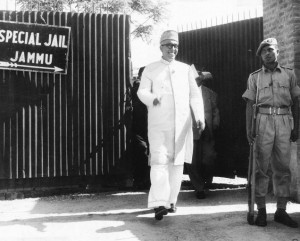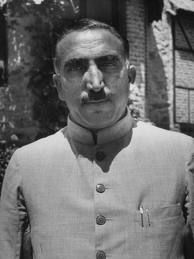Peace Watch » Editor's Take, Kashmir-Talk, Point of view » With the GST Job done- Is change of guard in state on cards
With the GST Job done- Is change of guard in state on cards
Punchline
The GST Job Done- and now contemplate a change of guard
Z. G. Muhammad
Seventy years is a long time for “governments” to master the art of creating proxies for foisting their will on dissenting population. In dealing with Jammu and Kashmir, New Delhi has phenomenally mastered this art. It has used power as bait to see the state fully integrated into the Union of India in contravention to the temporary ‘Instrument of Accession, ” and conditions laid therein and its commitments to people of the state and the comity of nations. To see its job done in the state, it also has mastered the art of using the loaf of power for pitching one politician against another. Ironically, after getting the job done through these “politicians,” it has been humiliatingly removing them from power even putting them in jails for installing the next one with yet new task for furthering its agenda and strengthening the hold on the state.
This harsh reality of Machiavellian politics in the State for past seventy years haunted my mind like the ghost of Banquo during the debate over the extension of GST to the State. Another move towards integrating of the state with the Union of India and eroding further the Article 370, governing relations between the State with the Union of India. Moreover, that has to be there till a referendum is held in the state.
The Article 370 had become necessary after India took Kashmir problem to the UN and it became an international dispute. The debate on this Article in the Constituent Assembly bears testimony to this historical reality. In his 17 October 1949, exposition of Article 370 Gopalaswami Ayyanger explaining the necessity of incorporation of this Article in the Constitution of India made it clear that this Article has to be there till final settlement of the future of the State. To quote him:
“There was cease-fire agreed at the beginning of the year, and that ceasefire is still on. The conditions of the State are still abnormal. They have not settled down…We are entangled with the United Nations regarding Jammu and Kashmir, and it is not possible to say now when we shall be free from this entanglement. That can take place when Kashmir problem is satisfactorily settled.” (Article 370 by A.G. Noorani p 67 and Essential Documents on Kashmir by P. Lakhanpal)
Sadly, enough some of the resistance leaders also are yet to see Article 370, as recognition of Kashmir as an unresolved problem in the Constitution of India. Moreover, understand the importance of preserving its sanctity. Thus instead of appreciating the concern shown by the civil society and traders over the extension of GST in its totality through their statements they strengthened the dominant discourse.
Coming back to the ‘dominant discourse’ on bringing state within the ambit of the GST and the ongoing debate about this Central Law, it was mainly silence of the Chief Minister and overenthusiasm of a minister for ensuring adopting of the law in letter and spirit that intrigued me. It made me believe that New Delhi is looking for a change of guard in the state and has perhaps identified the ‘overzealous minister’ as its a new choice.
If it happens, there would be nothing new in it. New Delhi, right from 1947, has used the posts of Prime Minister/ Chief Minister as bait for seeing its agenda for complete integration implemented. In 1947, Sheikh Mohammad Abdullah for following Nehru to the dot in seeing Jammu and Kashmir acceding to India was a hero for New Delhi. There are instances when on his arrival in New Delhi he was given a guard of honor as accorded to Prime Ministers of sovereign countries and received by none less than Prime Minister Nehru at the airport. It was done to boost his ego for pitting him against people of his state. Nonetheless, the much-applauded honeymoon hit the rocks in 1949, when he started questioning New Delhi’s backtracking from its commitment and intentions to fully integrating the State with the Union of India. The correspondence between Sheikh Abdullah and Gopalaswami and Gopalaswami and Sardar Patel shows how right in 1949; New Delhi had started thinking of removing Abdullah and installing his right-hand Bakshi as Prime Minister. In his letter of 16 October 1949, Sardar Patel to Gopalaswami shows his annoyance with Sheikh Abdullah. “Whenever Sheikh Sahib wishes to back out, he always confronts us with his duty to his people. Of course, he owes no duty to India or Indian Government… to Prime Minister who has gone all out to accommodate him.” It took New Delhi no time to cage its hero in a military operation just a few years later even after having signed a document of surrender, the Delhi Agreement. That paved the way for the integration of the state with the Indian Union. He was incarcerated, accused of conspiracy and tried for over a decade in camera.
 The new man Friday Bakshi after having done his job as dictated for ten years suffered the same humiliation. He was unceremoniously removed and jailed. Made to live in the wilderness, his political career sealed forever and his junior colleague Ghulam Mohammad Sadiq installed as Prime Minister/ Chief Minister of the state and given the task of bulldozing the Article 370. Ironically, both Bakshi Ghulam Mohammad and Sadiq couple of months before Abdullah’s arrest had vouched for holding of a plebiscite in the state under the supervision of the UN at the National Conference Working Committee meeting.
The new man Friday Bakshi after having done his job as dictated for ten years suffered the same humiliation. He was unceremoniously removed and jailed. Made to live in the wilderness, his political career sealed forever and his junior colleague Ghulam Mohammad Sadiq installed as Prime Minister/ Chief Minister of the state and given the task of bulldozing the Article 370. Ironically, both Bakshi Ghulam Mohammad and Sadiq couple of months before Abdullah’s arrest had vouched for holding of a plebiscite in the state under the supervision of the UN at the National Conference Working Committee meeting.
The dumping of Bakshi to the political dungeon, the appointment of Sadiq and him playing havoc with the autonomy of the state is a classic example of New Delhi’s use and throw politics in the State. Immediately after his installation, he started working for reducing the Article to a mere shell, starting with the sixth amendment to the state constitution changing the nomenclature of heads of state to the governor, prime minister to chief minister and extending one after another Central Law. Having done the job, right in 1967, during the Hindu agitation, it was subtly conveyed to him where he stood when CRPF refused to take orders from his government. Moreover, Mrs. Gandhi informed Syed Mir Qasim that New Delhi wanted to replace Sadiq. She also told him about Sadiq having lost the support of the legislature, and they wanted him to be the new chief minister. Death came to the rescue of Sadiq otherwise he would have suffered political wilderness and jail same as his predecessors. (For details see Syed Mir Qasim’ autobiography) In 1984, five months after signing the black warrant JKLF leader Mohammad of Maqbool Bhat was also shown the door and declared as a security risk- made to prostrate forever before the might of New Delhi.
So there will be no surprise, after having got the GST implemented New Delhi contemplating a change of guard in the state and appointing a new one for carrying further erosion in Article 370.
Published in Greater Kashmir on 10-07- 2017
Filed under: Editor's Take, Kashmir-Talk, Point of view








There are many aspirants for the hot seat as we can judge by the statements of condemnation of killing of yatries. was the death of Mufti Mohd Syed a natural or poisoning as was revealed by Prof. Bhim Sing. If so, was it a part of change of Gaurd too? if it happens now again who will be the next C.M. The people from Kashmir who pose to be too patriotic towards India on T V shows or a hindu from Jammu.